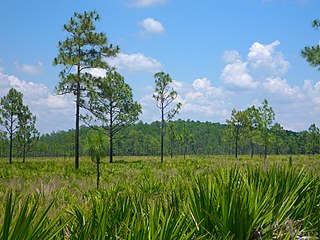Swamp cypress is a common name for more than one species of plants in the family Cupressaceae (cypresses):

Cupressaceae is a conifer family, the cypress family, with worldwide distribution. The family includes 27–30 genera, which include the junipers and redwoods, with about 130–140 species in total. They are monoecious, subdioecious or (rarely) dioecious trees and shrubs up to 116 m (381 ft) tall. The bark of mature trees is commonly orange- to red- brown and of stringy texture, often flaking or peeling in vertical strips, but smooth, scaly or hard and square-cracked in some species.
- Species of the genus Taxodium
- Taxodium distichum , native to the Southeastern and Gulf Coastal Plains of the United States

The Gulf Coastal Plain extends around the Gulf of Mexico in the Southern United States and eastern Mexico.

The United States of America (USA), commonly known as the United States or America, is a country composed of 50 states, a federal district, five major self-governing territories, and various possessions. At 3.8 million square miles, the United States is the world's third or fourth largest country by total area and is slightly smaller than the entire continent of Europe's 3.9 million square miles. With a population of over 327 million people, the U.S. is the third most populous country. The capital is Washington, D.C., and the largest city by population is New York City. Forty-eight states and the capital's federal district are contiguous in North America between Canada and Mexico. The State of Alaska is in the northwest corner of North America, bordered by Canada to the east and across the Bering Strait from Russia to the west. The State of Hawaii is an archipelago in the mid-Pacific Ocean. The U.S. territories are scattered about the Pacific Ocean and the Caribbean Sea, stretching across nine official time zones. The extremely diverse geography, climate, and wildlife of the United States make it one of the world's 17 megadiverse countries.
- Glyptostrobus pensilis , native to subtropical southeastern China
- Actinostrobus pyramidalis , native to southwest Western Australia

Taxodium is a genus of one to three species of extremely flood-tolerant conifers in the cypress family, Cupressaceae. The generic name is derived from the Latin word taxus, meaning "yew", and the Greek word εἶδος (eidos), meaning "similar to." Within the family, Taxodium is most closely related to Chinese swamp cypress and sugi.

Taxodium distichum is a deciduous conifer in the family Cupressaceae. It is native to the southeastern United States. Hardy and tough, this tree adapts to a wide range of soil types, whether wet, dry, or swampy. It is noted for the russet-red fall color of its lacy needles.

The Southeastern United States is broadly, the eastern portion of the Southern United States, and the southern portion of the Eastern United States. It comprises at least a core of states on the lower Atlantic seaboard and eastern Gulf Coast. Expansively, it includes everything south of the Mason-Dixon line, the Ohio River and the 36°30' parallel, and as far west as Arkansas and Louisiana. There is no official U.S. government definition of the region, though different agencies and departments use various definitions.
| This page is an index of articles on plant species (or higher taxonomic groups) with the same common name (vernacular name). If an internal link led you here, you may wish to edit the linking article so that it links directly to the intended article. |
















